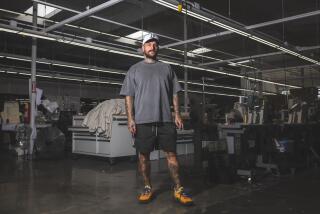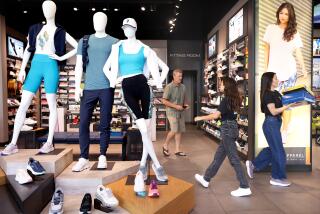Shoe Sales Slowing to a Walk : Retailing: Stores are seeing a shift away from athletic footwear with a lot of bells and whistles. But one company is betting big on a new lace-less model.
Ken Craig calls them “shoe freaks,” and he recognizes them as soon as they walk into his Athlete’s Foot store in Santa Monica.
They’re not afraid to wear bright colors, particularly on one of the dozens of pairs of athletic shoes they own. And they’re eager to talk tech, to debate the ins and outs of graphite inserts, air-filled soles, pumps, gels, hexalite cushions and polyurethane mid soles.
But while the 1980s brought the store thousands of shoe freaks eager to substitute one neon innovation for another, the ‘90s have spawned another breed. They’re older. They wear button-down shirts. And as soon as they protest that there are “too many colors” in the shoes lining his walls, Craig, the store’s assistant manager, recognizes his new customer: “Someone who wants a shoe they can wear sitting in the back yard and drinking iced tea.”
This is the customer--a more value-conscious shopper with an eye for less-expensive, simpler footwear--who analysts and manufacturers say is now driving the nation’s flagging athletic shoe market. This is also the customer whom Puma, the German athletic shoe manufacturer, will be reckoning with when it introduces a new shoe that dials, rather than laces, next month.
Puma U.S.A. President John O’Rourke is heralding the company’s new $125 Disc System shoe as “a very unique, truly functional product” that has provided the company “a fountain of optimism in an economy that’s pretty bad.”
But observers who have witnessed the Alpine rise and fall of at least a dozen product innovations over the past decade remain circumspect.
“This is an industry that will continue to have gimmicks come out,” said Gary Jacobson, an analyst with Kidder, Peabody & Co. “This one will go up and probably go down just as quickly.”
Neither Jacobson nor other industry followers predict that the disc shoe will create much change in the overall level of athletic shoe sales nationwide.
In 1991, wholesale shoe sales rose only 4%--an almost imperceptible change compared to the preceding five years when sales rose an average of 21% each year.
The apparent plateau of the industry is due to several factors, according to John Horan, publisher of the newsletter Sporting Goods Intelligence.
For one thing, Horan noted, the athletic footwear market represents 40% of the entire footwear market, twice the 20% it occupied 10 years ago. And that 40% may well represent sneaker saturation. As Horan said, “It’s not that there’s that many more feet.”
The other important factor contributing to the market’s flattening is the relative decline in shoe prices. Outlets now say their best-selling shoes are in the $40 to $60 range, down from the $80 and $100 shoes people easily paid several years ago.
“Like any consumer category, there’s now more emphasis on making sure there’s value to go with product innovation,” Horan said. “People are not interested in how many bows and whistles you can put on a shoe.”
Such a shift toward less ostentatious products reflects a general retail trend away from the status symbols of the 1980s--fashion driven by the recession, according to Robert Carr, editor of another trade newsletter, Inside Sporting Goods.
“People are not buying $100 Nikes to walk the dog anymore--that was a status thing,” Carr said. “The whole yuppie culture is gone.”
Carr predicted that “classic” athletic shoe manufacturers--such as Keds, K-Swiss and Converse--are most likely to thrive in this altered retail landscape. Other producers who hope to weather changes in the market are often shifting the types of shoes they produce and emphasizing their simpler, less-expensive lines.
Kevin LeVangie, marketing president of the Cherokee Group, said his company plans to increase its production of its basic canvas shoe from 5 million to 7 million this year.
“The canvas trend started a few years ago, and it just hasn’t slowed down,” LeVangie said. “That’s the major growth area--not hi-tech gimmicks.”
Following that trend, L.A. Gear on Tuesday announced that it will develop a traditional line of shoes: the “vintage line” of simple leather models to be sold in department stores for $35 to $50.
The troubled manufacturer has not completely abandoned its hi-tech interests, however. Another line of shoes that feature blinking, colored lights will be developed for the holidays although even these will be more moderately priced than previous innovations: about $50 for children and $80 for adults.
Given the general downscaling of the market, Puma’s introduction of a $125 shoe whose appeal lies primarily in a clear nylon, fishing-style line and a rotating twist closure seems a surprising tack.
Yet given Puma’s traditionally small share of the U.S. market--an uninspiring 0.77% in 1991--the new disc system may give the brand the sort of national name recognition that it has long coveted.
“This will create a new image of Puma as an innovator,” Carr said. “The disc shoes may not sell so well, but people won’t feel embarrassed by wearing Pumas.”
In fact, since announcing the introduction of its disc shoes, Puma has already persuaded two major retailing chains--Athlete’s Foot and Foot Locker--to carry its products. Neither chain had stocked the brand before.
O’Rourke hopes the company will sell 250,000 pairs of disc shoes this year and 500,000 in 1993. But he also conceded that much of the long-term benefit that the company hopes to derive from the shoe is “strengthening the brand’s image.”
In an industry where shoes are distinguished by the number, shape and iridescent shade of the stripes on their sides, image--as O’Rourke and others know--counts for a lot.
And in three weeks, when the Athlete’s Foot store in Santa Monica receives its shipment of green, black, turquoise and white Puma Disc System shoes, O’Rourke and others will be comparing their sales to those of the shoe currently displayed as the store’s “Hot New Style”: an all-white canvas K-Swiss model with a plain, rubber sole and long, old-fashioned, laborious white laces.
More to Read
Inside the business of entertainment
The Wide Shot brings you news, analysis and insights on everything from streaming wars to production — and what it all means for the future.
You may occasionally receive promotional content from the Los Angeles Times.










